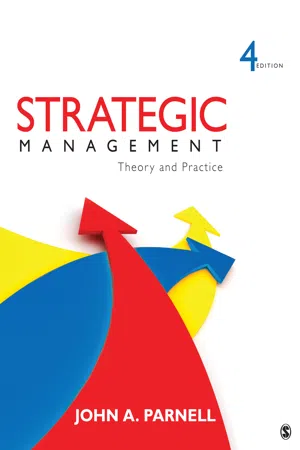Business
External Environment
The external environment refers to the factors, forces, and conditions outside a business that can impact its operations and performance. These may include economic conditions, technological advancements, political and legal regulations, social and cultural trends, and competitive forces. Understanding and adapting to changes in the external environment is crucial for businesses to remain competitive and sustainable.
Written by Perlego with AI-assistance
Related key terms
1 of 5
12 Key excerpts on "External Environment"
- eBook - ePub
Strategic Analytics
Integrating Management Science and Strategy
- Martin Kunc(Author)
- 2018(Publication Date)
- Wiley(Publisher)
3 External Environment: Political, Economic, Societal, Technological and Environmental FactorsObjectives
- To define exogenous factors
- To learn tools for foreseeing changes in exogenous factors
- To organize External Environment information for decision making
Learning outcomes and managerial capabilities developed
- To develop sensemaking managerial capabilities
- To classify the impact of external factors into threats and opportunities
Strategic choices are a function of conditions of the internal and external factors and the possibility of influencing them. The External Environment, or external factors, can affect the organization's choices as well as its performance so it is fundamental to consider them within the strategic management process even though it will be impossible to affect them. The closeness of the external factors to the organization implies the possibility for the organization to influence, within a certain time horizon, conditions of these factors. The External Environment can be divided into three parts according to the closeness to the organization: rivalry with existing organizations; industry dynamics defined by the suppliers, potential entrants, substitutes and customers; and the general or remote environment defined by the political, economic, social, technological and environmental factors (Figure 3.1 ).External factors affecting the organization.Figure 3.1External factors can not only be threats to the survival of the organization but also opportunities to achieve the vision defined for the organization or even redefine it. Therefore, organizations may need to design strategies to defend themselves against a threat or follow opportunities arising from favorable changes in the external factors. This chapter addresses the factors residing in the general or remote environment.Political
These factors examine the political situation since government regulations and legal issues play a role in its economy and can ultimately affect the organization. Examples of such factors are tax policies, environmental policy, labor laws, international trade barriers and tariffs. It is essential for organizations to asses and align themselves with these policies in order to devise strategies which will enable them to operate successfully in the market and, thus, avoid government pressures as an interested stakeholder. Government policies can become a huge impediment to the growth of an organization if they affect strategic choices in terms of business models. Government policies may also become highly beneficial if they are supporting the growth of the industry or creating barriers to avoid competition. - eBook - PDF
- Ricky Griffin(Author)
- 2021(Publication Date)
- Cengage Learning EMEA(Publisher)
To do so, therefore, the manager must first thoroughly understand the nature of the organization’s environments. 3 The External Environment is everything outside an organization’s boundaries that might affect it. As shown in Figure 3.1, there are actually two separate External Environments: the general environment and the task environment. An organization’s internal environment consists of conditions and forces within the organization. Of course, not all parts of these environments are equally important for all organizations. A small two-person partnership does not have a board of directors, for example, whereas a large public corporation is required by law to have one. A private university with a large External Environment Everything outside an organization’s boundaries that might affect it internal environment The conditions and forces within an organization Copyright 2022 Cengage Learning. All Rights Reserved. May not be copied, scanned, or duplicated, in whole or in part. Due to electronic rights, some third party content may be suppressed from the eBook and/or eChapter(s). Editorial review has deemed that any suppressed content does not materially affect the overall learning experience. Cengage Learning reserves the right to remove additional content at any time if subsequent rights restrictions require it. 62 endowment (like Yale) may be less concerned about general economic conditions than might a state university (like the University of Mississippi), which relies on state funding from tax revenues. Still, organizations need to fully understand which environmental forces are impor- tant and how the importance of others might increase. 3-2 THE External Environment As just noted, an organization’s External Environment consists of two parts. The general environment of an organization is the set of broad dimensions and forces in its surroundings that create its overall context. - eBook - PDF
- John R. Schermerhorn, Jr., Paul Davidson, Daniel G. Bachrach, Peter Woods, Fatima Junaid, Tui McKeown, Mary Jesselyn Co(Authors)
- 2022(Publication Date)
- Wiley(Publisher)
4 The ability to do this begins with the answer to a basic question: what is in the External Environment of organisations? The External Environment comprises the set of forces and events outside an organisation that can potentially have an impact on it. The External Environment is the ‘big picture’ that organisations have to respond to in order to survive and be successful. The External Environment can be divided into two components, as shown in figure 4.1: the general environment (or macro environment) and the specific environment (or micro environment). FIGURE 4.1 The External Environment Technology Sociocultural trends Advocacy groups Customers Organisation Industry regulation Suppliers Economy Political/ legal trends Competition S p e c ifi c e n v ir o n m e n t G e n e r a l e n vir o n m e n t N a t u r a l e n vir o n m e n t Creditors Figure 4.1 presents an overall view of an organisation and its general and specific environments. The small circle in the middle of the diagram represents the organisation. Around the organisation are its specific environments, which are encapsulated in a larger circle. Outside the large circle is the general environment. We will discuss each component in more detail in the succeeding sections. Pdf_Folio:94 94 Exploring management | 1st Asia–Pacifc edition EMERGING ISSUE Managing in crisis — how to help Chinese students locked out of Australia during COVID-19? Frank Wang exemplifes a small business owner who has successfully made changes in his busi- ness to respond to changes in his external envi- ronment. Frank was a travel agent who had to close his business during the COVID-19 pan- demic because the borders were closed for international travel. He accidentally stumbled on a business opportunity when a friend asked him to pack their belongings and send them to China. When others found out, they started approaching him for the same service. - eBook - PDF
- Paul Beynon-Davies(Author)
- 2017(Publication Date)
- Red Globe Press(Publisher)
From our point of view, the environment of most organisations can be considered in terms of four major inter-dependent systems: an economic system, social system, political system and physical system. In this sense, the External Environment can be seen to be made up of a network of activities and relationships in each of these systems between the organisation and other actors. In a sense, the previous chapter has already provided elements of a technology analysis for business, at least as far as ICT is concerned. We also choose to combine the consideration of political and legal issues together in a single section. An economic system consists of the way in which groups of humans arrange their material provisioning and essentially involves the coordination of activities concerned with such provisioning. An organisation’s economic environment is defined by activities and relationships between economic actors or agencies and the organisation. The economic environment is particularly concerned with the performance of national and international commerce and trade and is influenced by such factors as levels of taxation, inflation rates and economic growth. Informa-tion systems are critical to organisational performance within economic markets. Recently, growth has been experienced in specialised markets focused around the use of electronic networks. Not surprisingly, electronic business and electronic commerce have become significant strategies by which modern organisations improve their performance. The social environment of an organisation concerns its position in the cultural life of some grouping such as the nation state. The social system can be seen to be made up of a series of social networks consisting of activities and relationships that serve to bind various social groupings together. In this chapter we are particularly interested in the ways in which people relate to organisational activity through communities of consumption. - eBook - PDF
- David C. Bojanic, Robert D. Reid(Authors)
- 2016(Publication Date)
- Wiley(Publisher)
In other words, there is an emphasis on people and the planet, as well as profits. The hospitality and tourism industry is heavily affected by this initiative because it relies, to a large extent, on travel between destinations. Although visitors are a good positive source of economic impact on a destination, there are also negative impacts on the environment and the local community. Therefore, it is necessary for destinations to manage the positive and negative impacts related to their economies, environments, and society. This chapter will start with a discussion of the External Environment that affects hospitality and tourism firms, and then address the issue of sustainability. 2.2 THE External Environment When marketing managers consider changes in marketing strategy or tactics, they often examine the changes in five major components of the External Environment: economic, social, competitive, political and legal, and technological. Firms cannot directly influence their External Environment, but they can monitor changes and be somewhat proactive. It is critical for firms to engage in some level of environmental scanning, so they can take advantage of marketing opportunities while anticipating any threats to their business. Environmental scanning can be a formal mechanism within a firm, or merely the result of salespeople and managers consciously monitoring changes in the environment. The larger the firm, the more likely it will have a structured approach to scanning the environment and documenting trends. The following section contains brief descriptions of each of the exter- nal environments. 2.2.1 The Economic Environment The goal of all marketing activity is to create and satisfy customers. Consumers’ purchasing power, or ability to purchase products and services, is directly related to the economic health of the city, state, and country. - eBook - PDF
- Ellen Auster, K. Wylie, Michael Valente(Authors)
- 2005(Publication Date)
- Palgrave Macmillan(Publisher)
17 2 Assessing the external context We all know that the context in which our organization does business has many implications when it comes to change. In this chapter, we focus on assessing this external context, which is critical for diagnosing and devel- oping our understanding of “Where are we now?” in the SOC frame- work. More specifically, as shown in Figure 2.1, this approach considers three main components: • The macro forces in the business environment that impact our organiza- tion such as the latest social and political trends, economic forecasts, and technological advancements. • The competitive landscape in which our organization operates, including direct competitors and indirect competitors, competitive dynamics, core competencies, and key differentiators. - eBook - PDF
- Paul Sweeting(Author)
- 2011(Publication Date)
- Cambridge University Press(Publisher)
5.3 Political environment This leads neatly into the discussion of the political environment in which firms operate. There are two aspects to this type area. The first is the broad underlying environment. For example, to what extent is a firm operating in a free market environment, and to what extent is there government control and regulation? Is there a culture of redistribution of wealth, as seen through systematically high taxes and government spending? How great is the require- ment for disclosure, in relation both to the organisation and to its customers, policyholders or members? These factors can affect the very attractiveness of operating in an industry in a particular country; at the very least, they can affect the target market for customers. The second aspect of the political environment that is of interest is the political climate, which can change over time. As discussed above in rela- tion to stakeholders, public and media sentiment can turn against particular institutions. This frequently affects the political climate and can lead to stricter regulation, higher taxes or other restrictions on organisations. 5.4 Economic environment In this context, the economic environment refers to the point in the economic or business cycle rather than any capitalist/socialist comparison – this is discussed 5.4 Economic environment 63 Expansion Contraction Peak Trough Greed Correction Fear Revival Figure 5.1 The business cycle under the political environment. There are a number of depictions of business cycles, as well as time scales, with the longest being over fifty years; how- ever, the business cycle of interest here has a span of around a decade and is characterised by periods of expansion and contraction in gross domestic product (GDP), with associated peaks and troughs. - eBook - PDF
- Paul Sweeting(Author)
- 2017(Publication Date)
- Cambridge University Press(Publisher)
5 The External Environment 5.1 Introduction The external risk management environment refers to everything that can affect the risks faced by an institution and the way those risks are managed. These factors are not uniform, and vary by industry and geographical location. Even within a partic- ular industry in a particular country, different types of firms might find themselves in different environments. Small firms might be treated differently from large ones, and privately held ones will certainly be treated differently from publicly quoted ones. The list of potential firm-specific factors is extensive – but the important point here is that it is not sufficient simply to look at the industry and location and decide that all firms will be treated the same; rather, it is important every time to consider the nature of the firm and how this affects the external context. 5.2 External Stakeholders Since it was established in the previous chapter that the number of internal stake- holders was small, it follows that the number of external stakeholders that might exist is large. All principals except the owner-managers are external to the institu- tions. This means that the other holders of bank and insurance company debt and equity are external, as are pension scheme sponsors; all customers, policyholders, pensioners and other beneficiaries are external; and clearly the government, the markets and any statutory insurance arrangements are external. By contrast, the agents are generally the insiders. This is particularly true for banks and insurance companies, where only trade unions and external auditors can be considered external; however, for pension schemes, foundations and endow- ments, where more facilities are likely to be outsourced, then functions such as investment management and benefit administration are also frequently external. Professional and industry bodies and regulators are also external to the organi- - Triant G. Flouris, Sharon L. Oswald(Authors)
- 2016(Publication Date)
- Routledge(Publisher)
Effective strategies make it possible for a company to compete successfully in the aviation environment, but good strategies do not come without hard work and detailed planning from the CEO. A well-thought out strategy is the output of a thorough analysis of the environments affecting the company. Thus, determining the appropriate strategy should come directly from an assessment of the External Environment and the company’s internal environment. In this chapter, we will discuss the External Environment. The External Environment encompasses all of the relevant forces outside of the company’s control. While one company cannot have a major effect on these forces, changes in External Environmental forces can have a significant effect on the way the company does business. In other words, a company could be forced to change its business model or strategic direction based solely on a change in one of these relevant forces. Furthermore, just as there is a micro and macro analysis in economics, a company is affected by both macro and micro-environmental forces.The Macro External Environment
The macro External Environment consists of such things as the economy, unemployment levels, inflation, the demographics of the population, governmental legislation and regulations, political power and stability, technology and even the values and lifestyles of the society at large. The macro environment is shown in Figure 4.1 . A manager might think that these environmental forces are well beyond the scope of the company’s influence; however, failure to keep a close watch on these forces could cause an airline to be ill-prepared for the future.Figure 4.1 The Macro External EnvironmentLet us begin our examination of the macro External Environment with the economy. During times of economic prosperity, as was the case during the late 1990s, people have more disposable income. It is during these times when one might see an increase in leisure time activities, such as family vacations and weekend getaways. Economic prosperity means good times for airline-related companies. Conversely, airlines and related businesses suffer greatly during downturns in the economy because disposable income is less prevalent and the general public tends to stay closer to home. It is at times like these that the business traveler, rather than the leisure traveler, becomes the focus for many airlines.Unemployment is another macro environmental factor. During times of full employment, the labor market is a seller’s market. In order to attract good employees, a business might have to pay top dollar, or they might find themselves having trouble hiring enough qualified employees. In general, full employment goes hand-in-hand with economic prosperity, which can mean possibilities of expansion for the company. However, full employment might also cause an airline to curtail expansion plans because of the lack of qualified available labor. Inflation, like unemployment, can cause problems for the businesses as well. During times of high inflation, the leisure travelers tend to curtail travel and businesses tend to put plans for expansion on hold.- eBook - ePub
Strategic Management
Theory and Practice
- John A. Parnell(Author)
- 2013(Publication Date)
- SAGE Publications, Inc(Publisher)
entire industry. Specifics concerning how these factors affect a particular organization should be elaborated in the section on opportunities and threats, which is later in the analysis.Researching political-legal forces, as well as other environmental forces, requires some digging and intuition and a lot of reading. Rarely will one find a website that provides a comprehensive “macroenvironmental report” for a given firm or industry. When one is conducting research, it is often helpful to create four charts—one for each element in the macroenvironment—and add to it throughout the research process. One may locate direct and indirect references at the company home page and in various articles, but trade journals are often the best single source of information for reports on relevant issues in the External Environment. As many as two dozen (or more) different sources may be required to complete the analysis of the four macroenvironmental forces. It is rare that complete and thorough information can be found in only one or two sources.If a company competes in multiple industries (with multiple business units), one needs to analyze the major business units and industries. What constitutes “major” depends on the firm. For example, Ford Motor Company receives the majority of its revenues from automobile sales, but it also has a business unit that provides customer financing. With Ford, it would make the most sense to analyze its automobile business unit and not spend considerable time on the financial business unit. With other companies, however, determining which business unit or units are “major” may be more difficult. The key is to consider the relative contribution of each business unit to corporate revenues and profits. If questions remain, it is a good idea to present the professor with a list of the company’s business units and each one’s proportion of company revenues and profits, along with a proposal on how to proceed, and ask for guidance. - eBook - PDF
Strategic Management
Concepts and Cases
- Jeffrey H. Dyer, Paul C. Godfrey, Robert J. Jensen, David J. Bryce(Authors)
- 2021(Publication Date)
- Wiley(Publisher)
FIGURE 2.3 Trends in Opportunities and Threats in the General Environment Social/Cultural Forces Political/Legal/ Regulatory Forces Global Forces Technology Change General Economic Conditions Demographics Ecological/Natural Environment Complimentary Products/Services THE GENERAL ENVIRONMENT COMPETITOR RIVALRY BUYER POWER SUPPLIER POWER NEW ENTRANTS SUBSTITUTES How the General Environment Shapes Firm and Industry Profitability 31 Strategy in Practice COVID-19 Alters Industry Profitability Overnight Shortly after the World Health Organization designated COVID-19 as a global pandemic, nations, states, cities, and towns responded with “lockdowns” of varying severity. For weeks people remained at home, and for months after most people limited their outside of home travel and visits. The total output of goods and services in the United States, its GDP, fell 31.4 percent. The economy was reeling, but the devastation was not evenly spread over industries. As Figure 2.4 illustrates, some industries and sectors of the economy lost massive amounts of money, while others saw their profitability increase. Industries such as airlines and cruise ships saw their business drop to almost nothing, while cargo shippers such as Amazon, Fed- eral Express, and UPS saw their revenues and profits soar. Food delivery services, such as Domino’s Pizza, Door Dash, and Uber Eats, saw industry revenue grow. Clothing and apparel retailers saw their profits plummet, while building supply retailers saw their business take off. As you look at the data above, why did some industries thrive while others tanked? Source data: Yan Wu, Covid-19 Pummeled Corporate America Into Its Worst Quarter in a Decade. But Not All Suffered, The Wall Street Journal, 18 August 2019. FIGURE 2.4 32 CHAPTER 2 Analysis of the External Environment: Opportunities and Threats Complementary Products or Services Complementary products or services are those that can be used in tandem with those in another industry. - eBook - PDF
Strategic Management
Concepts and Cases
- Jeffrey H. Dyer, Paul C. Godfrey, Robert J. Jensen, David J. Bryce(Authors)
- 2020(Publication Date)
- Wiley(Publisher)
Many firms have responded by implementing green initiatives. Although some of these may be for public relations purposes only many firms have established serious goals. For instance, Procter & Gamble has goals to use 30 percent renewable energy to power its plants by 2020. By 2014, 7.5 percent of its energy needs were already met by renewable energy. They have also promised to reduce their energy consumption, water usage, greenhouse gas emissions, and waste by 20 percent by 2020. They have already reduced them by 8 percent by 2014. 46 If consumers truly care about the environment, then actions like these increase rivalry as competitors are forced to respond in kind. 36 CHAPTER 2 Analysis of the External Environment: Opportunities and Threats Global Forces Global forces also play a large role in shaping many industries. Over the last 50 years, as com- munications and transportation technologies have undergone a revolution, trade barriers among nations have fallen dramatically. Many countries, from South Korea and Taiwan, to China and India, to Brazil and South Africa, have enjoyed remarkable economic growth and a rising standard of living. These changes have caused firms from many countries to expand operations and begin producing and selling across national borders. We will examine global forces and strategies for capitalizing on them in greater detail in Chapter 9. Political, Legal, and Regulatory Forces Political, legal, and regulatory forces are those that arise from the use of government. When new laws are passed, they may alter the shape of an industry and influence the strategic actions that firms might take. 47 For example, the federal Affordable Health Care Act, enacted in 2009, mandated that health insurance companies insure everyone, including those with preex- isting conditions.
Index pages curate the most relevant extracts from our library of academic textbooks. They’ve been created using an in-house natural language model (NLM), each adding context and meaning to key research topics.











